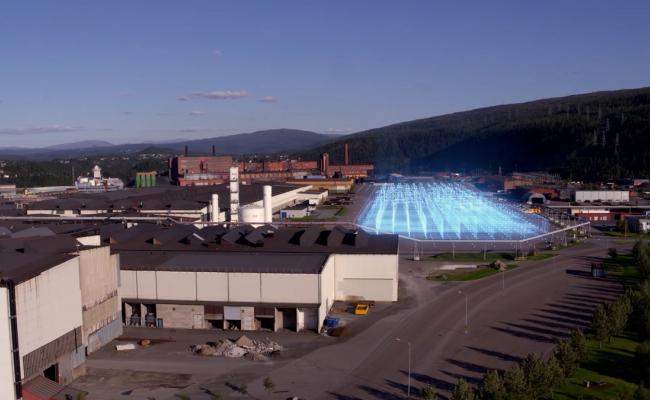Freyr EVP Operations: “Opening Pilot Factory in 2022”
The first battery cells are to leave Freyr’s pilot line as early as next year. Executive Vice President Operations Tove Nilsen Ljungquist says they have to start recruiting now in order to be ready for touchdown. Ljungquist was one of the speakers at NITO’s engineering conference in late August. (Photo: Trine Jonassen)
Following two years of planning, Executive Vice President Operations at Freyr’s battery factory in Mo i Rana, Norway presents its progress plan for the startup. “We have to bring in engineers from outside in order to make this happen”, says Executive Vice President Operations Tove N. Ljungquist.
“The challenge is to enter the market as fast as possible. The demand for green batteries is enormous, so our challenge will be qualifying our batteries fast enough”, says Executive Vice President Operations at the Freyr battery factory in Mo i Rana, Norway Tove Nilsen Ljungquist to High North News.
“In order to meet this challenge we have already started building a Customer Qualification Plan in Mo i Rana. This factory will have a high degree of flexibility to qualify various raw materials and products, and it will also be a training arena for our employees who are to work in the large commercial giga-plants”, the EVP says.
The company is as per today working for this pilot plant to be up and running by 2022. After that, two giant plants are to come into operations, one in 2023 and one in 2024. By 2025, a total of four plants are scheduled to be operational in Mo i Rana, encompassing an overall staff of 1,500 – most of whom are to be engineers.
Trimmed for the startup
The first battery cells are to leave Freyr’s pilot line as early as next year. Ljungquist says they have to start recruiting now to be trimmed for the startup.
“We need broad professional expertise and staff with high formal competence in technical areas such as automation, electronics, mechanics, electro-chemistry, cybernetics, statistics, analysis. We also need professional operators in the same disciplines”, Ljungquist explains.
We have to bring in the critical mass from outside
“We have now started hiring people for our customer qualification factory and during next year, we will have staff working at the giga plant. Training through participation in installation and testing of production equipment will be an important activity in order for us to have well-trimmed teams ready for startup”, Ljungquist says.
A Freyr academy
She says there is a race to reach the largest customers and establishing good contracts. Thus, they have to be innovative in recruiting. In order to meet the demand for competence, Freyr is currently establishing a training program tailor-made for Freyr’s needs – a Freyr academy – that will secure all aspects of operations.
“We do this to make sure we become the world’s best battery producer in all meanings of the word; security, quality and sustainability, supply time, and cost”, the EVP explains.
Since Norway does not educate enough engineers to cover the need, both Freyr and others in the same industry look abroad. At the same time, they keep their eyes open for relevant competence holders from other industries, such as oil and energy.
“We have to bring in the critical mass from outside. I believe that if we play our cards right when it comes to career opportunities and an exciting job, many newly educated will want to come here. In my experience, young people – in particular engineers – want an interesting job with development opportunities, rather than counting the number of sunshine days. We recruit from both England, Asia and Eastern Europe”, Ljungquist says.
Also read
Education lagging behind
A Teknisk ukeblad article [TU is a Norwegian tech journal, journ.note] reveals that engineers constitute some 20 percent of the workers needed for battery factories. Calculations show that the battery industry will need some 2,000 engineers by 2025. In addition there are all the engineers needed for research and development.
“We need two to three times as many engineers by 2030”, Professor Done Stokke Burheim at the Institute of Energy and Process Technics at NTNU in Trondheim, Norway says to the journal.
Each year, NTNU graduates 150 engineers who more or less hold the capacity needed for the battery industry. About 15 of them have specialized in battery this year.
Education is clearly lagging behind demand.
Working on education
“We work towards NTNU to offer both bachelor and master students as well as PhD candidates work with us. A rough estimate indicates that ten percent of our staff will be trainees and people in training”, Ljungquist explains.
She points out that not all need to be engineers; they will also employ staff with other relevant background and education. So far, Freyr has some 160 employees and many of these have relevant battery competence or experience.
“We cooperate with Sintef, amongst others”, the Executive Vice President Operations says.
You have announced that you are cooperating with Finnish Minerals. Are you planning to move parts of the production to Finland?
“No. We are establishing business in Mo i Rana, Norway to stay there. This is heavy industry that cannot easily be moved”, Ljungquist says.
Freyr has been listed on New York Stock Exchange since January this year.
This article was originally published in Norwegian and has been translated by HNN's Elisabeth Bergquist.



